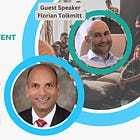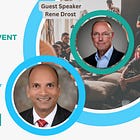Insights from 5 recent Let's Talk Risk! conversations: July-Aug 2023
Catch up on recent conversations you may have missed.
Note: Each week, we talk to risk practitioners and thought leaders in a live LinkedIn audio event1. These are very casual and informal conversations about practical challenges and best practices for risk management of medical devices. Key highlights are published each week on Saturdays. Here are highlights from 5 recent Let’s Talk Risk! conversations you may have missed.
1. Clinical evaluation is now more important than ever under EU-MDR
There is a new emphasis on clinical evaluation in EU-MDR, where it is referenced more than 130 times! One reason why manufacturers are struggling to comply with EU-MDR requirements for clinical evaluation is that they are no longer able to claim “equivalence” to an existing device under the revised criteria. As a result, clinical data generated previously is not considered to be sufficient.
An important point to consider here is that the clinical evaluation and risk management processes are closely related. That is why it is important to clearly understand the interface between clinical evaluation and risk management.
Florian Tolkmitt talks about challenges and opportunities for risk practitioners in the industry in the new regulatory environment. He recommends that we should treat clinical evaluation as a process and not simply a document for compliance.
Listen to the full recording of our conversation below.
2. How QA/RA professionals can help drive innovation in AI/ML
There is a lot of hype around artificial intelligence (AI) and machine learning (ML) these days. That is why it is important for Quality/Regulatory professionals to go beyond the hype and understand these rapidly emerging technologies at a deeper level.
AI/ML technologies are advancing rapidly and increasingly applied for medical purposes. The regulatory framework is also evolving to ensure a least burdensome approach without creating barriers to innovation. This new environment offers a lot of opportunity to QA/RA professionals to grow their careers by helping their organizations navigate the changing landscape.
Michael Bocchinfuso recommends that QA/RA professionals build a solid understanding of AI/ML terminology to help articulate benefits and risks when deployed as a medical device. It is useful to anticipate regulatory questions about model bias to plan a suitable response. Understanding risks arising from the use envrionment is also important. Finally, QA/RA professionals should collaborate with their peers in product development to help facilitate both safety and effectiveness of AI/ML based medical devices.
Listen to the full recording of our conversation below.
3. Risk based approach to building a QMS in a startup
Establishing a Quality Management System (QMS) in a startup is no easy task! Unlike a mature, established organization, a startup operates in a fast-paced and rapidly changing environment. That is why you have to think about both speed to support the near term goals, and scalability to support rapid growth in the future.
In the near term, speed to market is most important. It is good to be nimble in our approach to the QMS, but we should also not ignore the value of building a good foundation for the future. It is useful to take a project-based approach so that a QMS is implemented in time to support product launch.
We have to focus on building the right mindset about Quality; that it is not about slowing the pace of innovation, but about taking advantage of our work to reduce wasted effort and to improve the chance of success. When we build a habit of documenting our work, we can keep track of what worked and what didn’t. In this way, good documentation habits can support both innovation and regulatory compliance.
Becki Hiebert recommends using a risk-based approach and building flexibility in procedure and workflows. The QMS should facilitate speed to market while also being fully compliant with regulatory requirements.
Listen to the full recording of our conversation below.
4. Risk management lessons learned from running the Boston marathon
Boston marathon is one of the most prestigious running events in the world. Runners from all over the world aspire to run Boston at least once in their lifetime! But it takes a lot of hard work and preparation to even qualify to enter the race. It is not an easy task to get to run in Boston and finish the race.
Just like the Boston marathon, risk management is a challenging exercise in practice. Planning is absolutely essential for success, which is why a risk management plan is a key requirement of ISO 14971. You need to engage and collaborate with a cross-functional team for different risk management activities. But sometimes, things don’t go as planned. Often you have to take a step back and course-correct. There are always surprises along the way, especially during the post-market phase of the device lifecycle. That is why we need to be both agile and disciplined in our approach.,
Christopher Gehring shares some of the lessons learned as he trained for the Boston marathon.
Listen to the full recording of our conversation below.
5. Team diversity helps boost competence in risk management
Recalls are common in our medical device industry. When investigating the contributing factors behind device malfunctions resulting in a recall, it is common to find obvious issues that should have been fixed during design and development. In hindsight, it is easy to point out issues and say that the engineers should have anticipated these scenarios and designed safeguards in the device. But engineers are driven to product an optimal design that meets a whole range of requirements that often require a lot of trade-offs.
The gap is in the process of establishing requirements, not in the design and development process. Risks related to all potential hazards, including those arising from reasonably foreseeable misuse, should be considered prior to establishing design requirement. That is where team diversity can help.
Rene Drost highlights the importance of including a diverse range of perspectives, especially during early design and development, to consider a broad range of potential use scenarios. If we have team members with diverse life experiences and expertise, we have a better chance of starting with a more complete list of design requirements, including safety-related requirements.
Listen to the full recording of our conversation below.
Connect with Dr. Naveen Agarwal on LinkedIn to be notified of announcements of the weekly Let’s Talk Risk! events.







